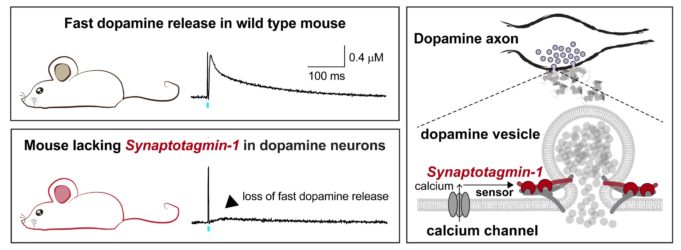By Aditi Banerjee
Neurons within our brain communicate via by releasing chemicals called neurotransmitters. One of these crucial neurotransmitters is dopamine, which controls behaviors such as movement and motivation. A lack of dopamine can lead to motor function disorders, like Parkinson’s disease, and abnormal levels of dopamine is associated with schizophrenia. Dopamine, like other neurotransmitters, is stored in small vesicles within the neuron before it can be released. Neurons release neurotransmitters in response to a rise in intracellular calcium, and proteins called calcium sensors sense calcium levels within the neuron to trigger release of these neurotransmitters. Secretory cells use a variety of calcium sensors, and the type of sensor protein used often determines the speed and precision with which a signaling pathway can be turned on and off.
For dopamine secretion, it was previously thought that release is slow and imprecise. However, recent studies from our laboratory showed that dopamine is released on a millisecond timescale, thereby suggesting that dopamine can signal rapidly and precisely. Rapid release is generally triggered by fast calcium sensors at other synapses. However, the neurobiology behind the fast dopamine release of calcium sensing is unknown.
We set out to identify the calcium sensor underlying fast dopamine release using experimental approaches to specifically delete the fast calcium sensor, Synaptotagmin-1, within dopamine neurons in mice. Fast dopamine release in the striatum was completely abolished in these mice, clearly suggesting that Synaptotagmin-1 is the fast calcium sensor for dopamine release. Interestingly, a slow form of dopamine release was also detected, and this release persisted even after Synaptotagmin-1 was removed, suggesting that other slow calcium sensors might be present.

Synaptotagmin-1 acts as the fast calcium sensor to support dopamine release.
Our work suggests that there are fast and slow dopamine signals in the brain, and that the fast signals require a calcium sensor protein that is often used for ultrafast signaling: Synaptotagmin-1. Identifying key proteins involved in dopamine release will help us better understand dopamine neurobiology. Impaired dopamine neurotransmission occurs in several brain disorders, for example Parkinson’s disease, substance abuse, and schizophrenia. A deeper understanding of the molecular machinery of dopamine release may ultimately provide new avenues to manipulate dopamine signaling when it breaks down in these brain disorders.
Aditi Banerjee is a postdoc in the lab of Pascal Kaeser at HMS.
Learn more in the original research article:
Synaptotagmin-1 is the Ca2+ sensor for fast striatal dopamine release. Aditi Banerjee, Jinoh Lee, Paulina Nemcova, Changliang Liu, Pascal S Kaeser. eLife 2020;9:e58359
News Types: Community Stories
